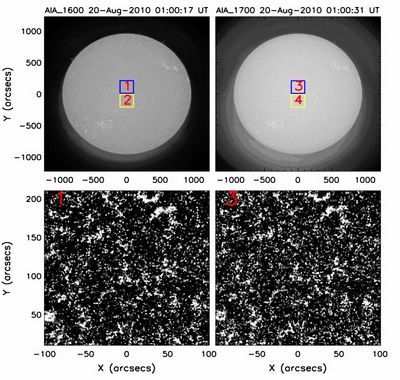
By with LI Dong
The full-disk images from SDO/AIA_1600 (left panels) and SDO/AIA_1700 (right panels) on 20 August 2010. The boxes mark the regions with the positions [-100″:100″;10″:210″-100″:100″;10″:210″] on northern hemisphere
In the past, X-ray bright points (XBPs) have been well studied. They are the prominent dynamical features in quiet Sun and coronal holes. These features were first seen by Vaiana et al. (2011) investigated the variability in temperature as a function of time among a sample of XBPs, and they found that the XBPs show a high variability in their temperature and that the average temperature ranges from 1.1 MK to 3.4 MK. Thanks to the high-resolution images from Hinode/XRT, the XBPs are resolved and can be seen to have complex loop-like structures. Ueda et al. (2010) measured the orientation of such loop structures for 488 XBPs and found that the distribution of the orientation is slightly but clearly biased to the East–West direction.
The AIA onboard SDO provides an unprecedented view of the solar corona in multiple wavelengths nearly simultaneously. The spatial and temporal resolutions of AIA are 0.6 arcsecs per pixel and 12 s, respectively. AIA contains four telescopes and provides narrow-band full-disk images in multiple EUV and UV bandpass, including 1600 Å and 1700 Å. Much more further details can be found in Lemen et al. (2012). HMI onboard SDO is designed to study the magnetic field at the solar surface. It provides full-disk magnetograms at 6173 Å with resolution of 0.5 arcsecs per pixel. The temporal resolution of line-of-sight (LOS) magnetograms is 45 s.
The observations performed in this paper are the full-disk AIA_1600 images, full-disk AIA_1700 images and full-disk HMI LOS magnetograms detected on seven days from 19 to 25 in August 2010. The Sun is quiet at these days and no active region appears around the solar disk center. We study the detailed properties of UVBPs at 1600 Å and 1700 Å at two regions symmetrically on northern and southern hemispheres each day, respectively.
This work by LI Dong NING Zhongjun has been accepted to be published in New Astronomy, please see New Astronomy,23-24,19-26, for more details (http://www.sciencedirect.com/science/article/pii/S1384107613000158)
